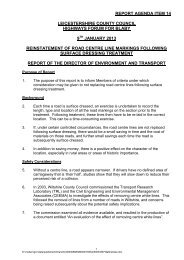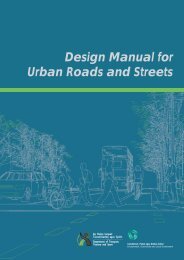Pedestrian Comfort Guidance for London
Pedestrian Comfort Guidance for London
Pedestrian Comfort Guidance for London
You also want an ePaper? Increase the reach of your titles
YUMPU automatically turns print PDFs into web optimized ePapers that Google loves.
A key part of the research into pedestrian com<strong>for</strong>t on footways was to investigate the real impact<br />
of street furniture on peoples’ behaviour and the amount of space on the footway. There<strong>for</strong>e the<br />
buffers defined <strong>for</strong> each type of street furniture include the average “static activity” associated with<br />
the furniture, that is, people waiting, queuing, talking, taking photographs etc.<br />
If there is an unusual amount of static activity (e.g. because a bus stand is served by a large number<br />
of services) or, because of the area, people are standing and waiting in areas they normally would<br />
not (e.g. near guard rail in a tourist attraction or regional retail site), then an additional static survey is<br />
recommended.<br />
A number of factors should be taken into account when conducting a static activity survey <strong>for</strong> a<br />
footway:<br />
•<br />
•<br />
•<br />
•<br />
•<br />
Static Activity<br />
How many locations and where? The initial site visit should have indicated locations where static<br />
activity occurs at the site. Locations near street furniture and transport connections are the usual<br />
locations. Samples should be taken within a 6m zone either side of your location.<br />
Recording the location: An exact reference <strong>for</strong> the sample location(s) should always be recorded<br />
on a map with a text description (e.g. stand in front of Halifax, facing WH Smith) and photograph<br />
<strong>for</strong> future reference.<br />
Per<strong>for</strong>ming the survey: The counts should be taken using the “snap shot” methodology whereby<br />
the observer records with a “x” on a printed map all pedestrians who are standing still within<br />
the survey location. This is like taking a photo of each section and the observer need only note<br />
what was happening when they first stopped and looked. The images below show a bus stop in<br />
Brixton and how a data collection book <strong>for</strong> the same scene is likely to look.<br />
Sample length and hours of survey: This will depend on the purpose of the study but should<br />
match the flow activity being collected. That is, once every half an hour if five minute samples are<br />
being collected or twice every half hour if 10 minute samples are being collected.<br />
Calculating the impact of static activity: Once the data has been collected the impact of the<br />
static pedestrians can be considered by either inputting the standing locations recorded into GIS<br />
using scaled people markers or if it is a simple queue that behaves consistently throughout the<br />
day by using a standard body ellipse (0.6m wide, 0.45m depth) plus 0.5 buffer (0.2m beside the<br />
wall or kerb and 0.3m between the static person and people walking by).<br />
Figure 18 Brixton High Street looking South<br />
Figure 19 How a static survey of Figure 18 may look<br />
35




